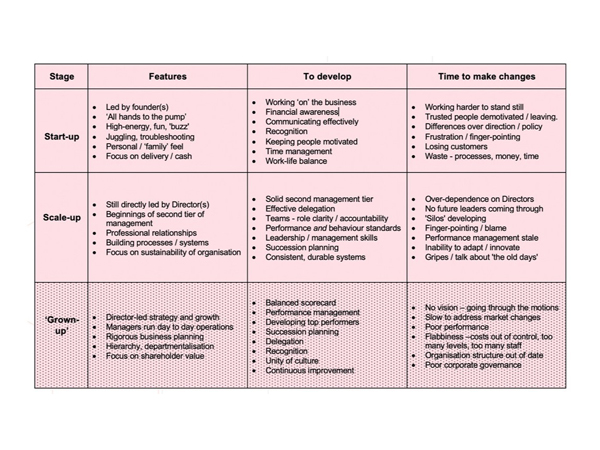In the middle, between ‘start-up’ and ‘corporation’, there is another type of business – the second generation ‘scale-up’ organisations.
In the UK, these ‘Small to Medium-sized Enterprises’ form more than 99% of all businesses and employ over 12 million people. Your SME will typically turn over anything from £2m to £50m and employ from 10 to 250 people.
How to steer it as it grows
An SME doesn’t need the full raft of corporate structures to work well, but as it scales up, it needs to be guided in a different way from the informal ‘family’ structures and methods you could use when it was smaller. Do you ever find yourself thinking:
- “Why does everything end up on my desk?”
- “Nobody shows any initiative – it’s like managing a bunch of children.”
- “Why can’t I get people to do what I want them to do?”
- “I do everything I can to look after them, yet they still complain.”
These are all signs that your informal leadership style and structures are running out of road. ‘Scale-up’ organisations need to be structured more than start-ups, but this doesn’t mean ‘corporate’ systems. In fact, people moving to SMEs from corporates very often fail precisely because they try to over-engineer the organisation.
How can you know where you are on the growth path?
Check out the signs and symptoms in the chart illustrated above. The third column shows the signs that it may be time to make changes. Remember, this is all in the area of working on your organisation – you’ll still have all the work of working in the business (production, marketing, finance etc) to keep going too!
It’s difficult to find time to work on the organisation when other matters always feel more urgent. However, just listen to your own complaints about managing the people and the operation, and you’ll quickly realise that these are issues that will one day blow up and derail growth. It’s counter-intuitive, but it’s crucial to make time to develop and build the infrastructure to support the scaled-up operation you aspire to lead – and it’s better to do it now than to wait until you have to react.
What are the priorities?
The priority things you should be working on in your scale-up are in the second column:
- Create rock-solid teams, starting with your own top team. Every member should have clarity around the roles that will be needed for the next phase of the business (not as they appear now). Do this with the whole team together: the outcome should be that everyone in the organisation is working towards the same goals, knows exactly what is expected of them and is committed to a practical process for keeping it all in place – because all of you have been involved in designing it.
- Then start building a solid second tier of management who can start to take from you the day-to-day hassles of running the operation – each with similar clarity around roles and accountabilities.
- Download from your and others’ heads the essential ‘ways we do things around here’ – you must never be beholden to any one individual, including yourself, in the way your business is run.
- Create performance and behaviour standards that everyone understands – and implement a performance management process that is a living, working tool for day-to-day management of the business.
…and that’s just the first year! The timeline for moving a Founder-owned and -run business from the ‘start-up’ stage to a fully mature level of operation that is fully sustainable without constant watchfulness from any one individual is anything from 2 to 4 years.
Do some thinking NOW!
What are your aspirations for yourself and your business? When would you like to retire, or at least become less actively involved in the business? Are you hoping to sell it and cash in at some time in the next few years? Do you want it to be an attractive prospect for an eventual purchaser? Or are you the kind of business owner who just takes enormous pride in the excellence of every aspect of your business operation?
Be guided by your answers to the questions. Get on the front foot and put solid foundations in place for the sustainable future of your business.
Pay your organisation attention now, and you will find, not only that results will improve, because everybody is now being held accountable for doing all of their job, but that individuals feel appreciated, motivated, and, yes, rewarded. You only have to look at organisations operating in under-resourced areas such as charity, the arts or alternative health, to see that it is possible for people to be incredibly motivated and satisfied for very little financial reward – provided they are managed, involved and appreciated.
A virtuous circle
When your organisation is delivering good results, then there will be additional resource to give people salary increases and a bonus – not as a substitute for hands-on management, but as an added extra reward. You’ll be able to fund the training and development people crave. Your organisation will grow and there will be room to promote people who make the grade.
And the more people develop and assume full accountability for the running of the business, the more successful your company will be.
And all by making sure everyone knows what to do, gets the reward of knowing he or she is doing exactly what’s required, and is fully acknowledged and appreciated for doing it.
